Now you can make seitan without gluten! This Gluten-Free Seitan Roast has a deep meaty flavour, a soft, meaty, slightly chewy texture and is just perfect for slicing and serving for holiday dinners or Sunday roasts.
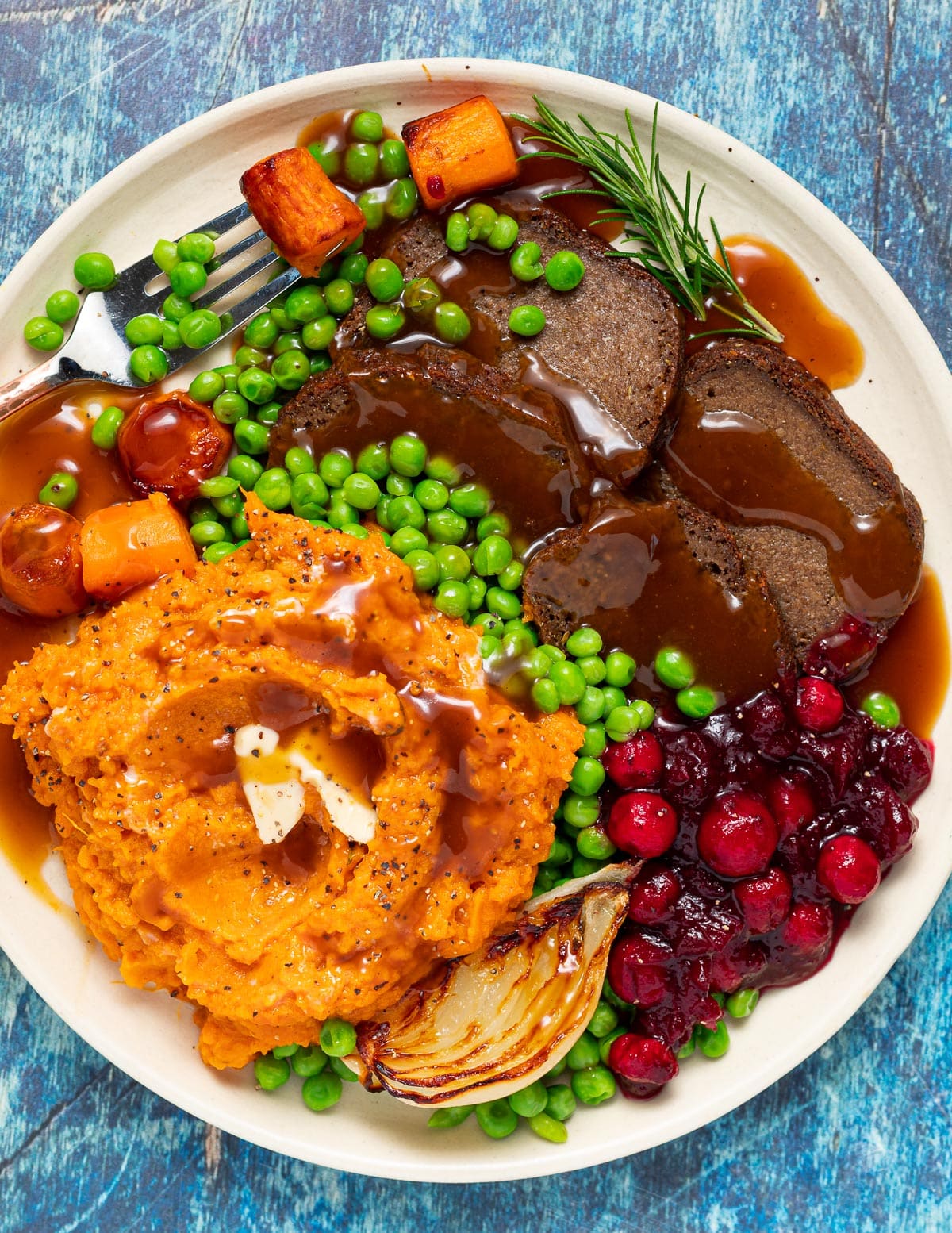
💌 SAVE THIS RECIPE!
Watch out for more tasty treats coming your way too! Unsubscribe at any time.
Stop wasting your money on pricey vegan meat alternatives and make your own instead because I'm busting the myth that seitan has to be made from vital wheat gluten!
With a few key ingredients, I've developed this meaty tasting, picture-perfect Gluten-Free Seitan Roast. Plus, you can prep it days ahead of time and enjoy it whenever you want.
Way cheaper than buying a premade vegan roast (that are usually full of gluten), this gluten-free seitan roast is perfect for serving with your vegan holiday dinner or Sunday roast. Make sure to include these melt-in-your-mouth sweet potatoes or some vegan mashed potatoes, roasted red cabbage and plenty of delicious gravy too!
Jump to:
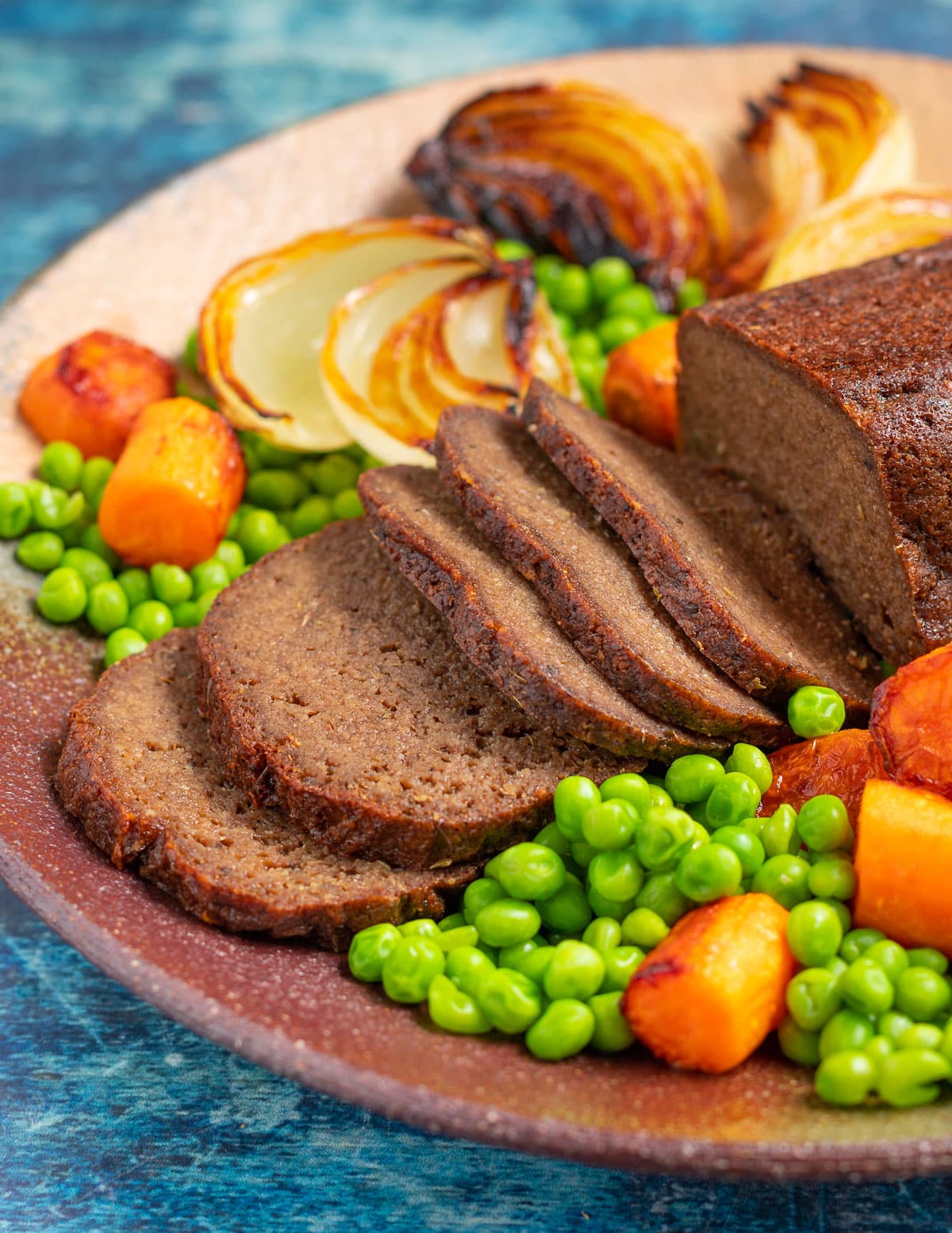
What is seitan?
Seitan (pronounced "SAY-tan"), also known as "wheat meat", is a vegan meat alternative made from vital wheat gluten. I have recipes for a vegan roast and vegan beef and both are seitan-based. Your favourite vegan deli slices, sausages, or bacon are probably made with a seitan base. When the gluten is isolated from the starch in wheat, it turns into a product that's very similar in texture to meat.
Once the seitan dough is formed from the wheat gluten, it's flavoured and cooked by either steaming, baking, or simmering in water or broth. After it's soaked in all of the flavours, it can be sliced and cooked right away or stored away for later. It's delicious as a holiday roast, in sandwiches, or marinated and added any number of other meals.
Of course though, this vegan roast recipe is completely gluten-free and very different from traditional seitan. Read on to discover how to make it!
Is seitan gluten-free?
Traditional seitan is far from gluten-free. In fact, its main ingredient is gluten. But, with a little plant-based magic, a seitan style roast can be made gluten-free.
Unfortunately, we'll never replicate the exact meaty texture of normal seitan without using the gluten, but this is pretty close, with a texture like very tender meat, and it has an amazing meaty flavour!
Unlike most regular seitan recipes though, this gluten-free version must be baked in the oven and not simmered or steamed. It will not turn out well if you don't bake it.
What ingredients and equipment do I need?
Here is what you will be needing to make my gluten-free seitan roast:
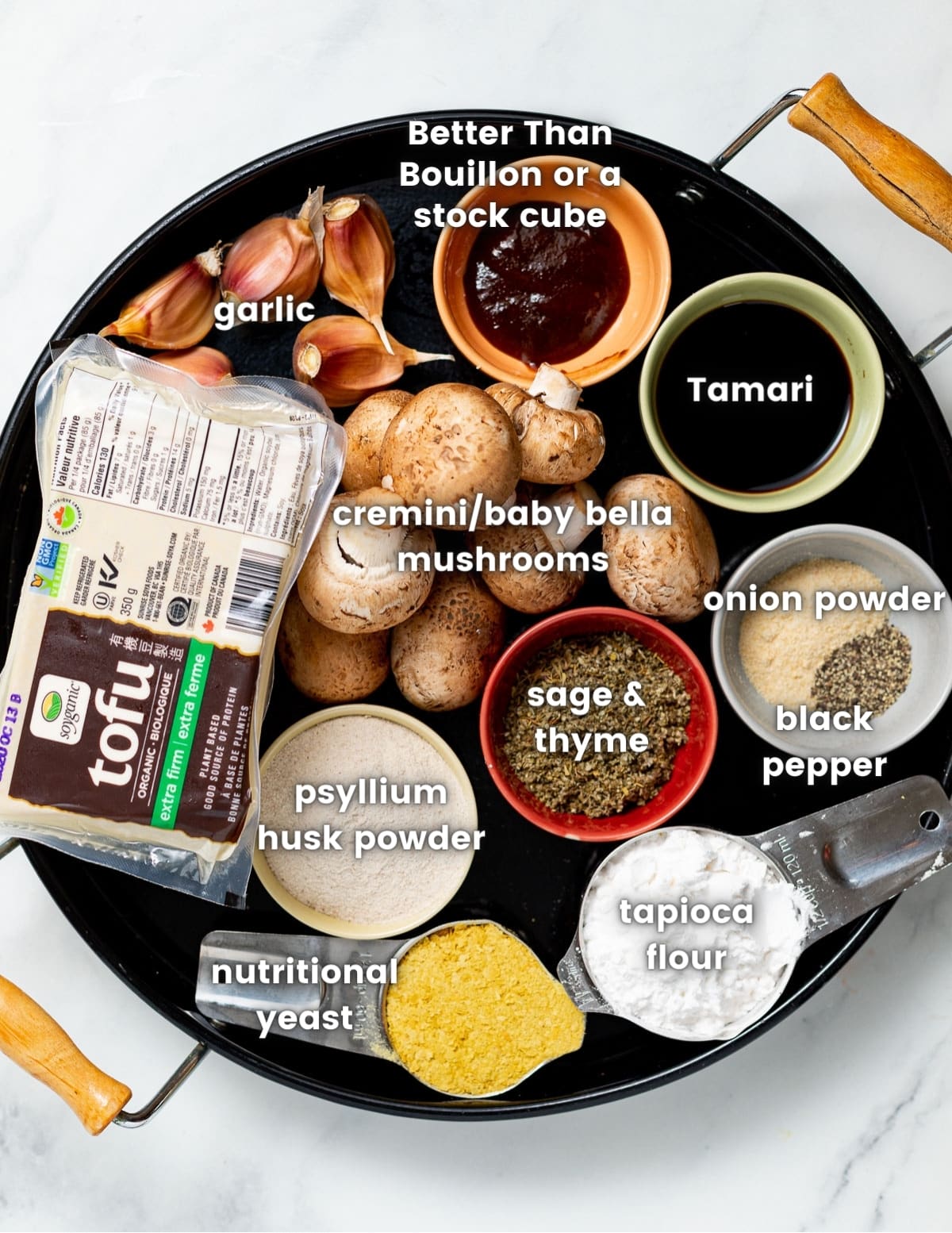
Most of the ingredients are pretty straightforward and if you already follow a strict gluten-free diet you are probably familiar with the ones that aren't, like psyllium husk powder and tapioca flour. Just in case you aren't though, here's a little about the main players in this recipe:
- Extra-firm tofu - It has to be extra firm. No other kind will do. And it should be frozen in the packets it came in (without opening them) for at least 2 days, then defrosted before making this recipe. So this recipe does take a little advance planning. This freezing and defrosting technique changes the texture of the tofu, making it drier and more textured which is really important for this recipe to turn out well.
- Tapioca flour - This helps to bind everything together and gives the roast a slightly chewy texture.
- Psyllium husk powder - This is what gives the seitan substance and a meaty texture. It's often used in gluten-free baking to help replicate the texture of wheat flour and in this recipe, it is used to replace the vital wheat gluten. The recipe will not work without it. You can find it at most big grocery stores or health food stores, pharmacies, or online.
- Seasonings - Like dried thyme, sage (rubbed or dried), nutritional yeast, onion powder, fresh garlic, and black pepper. All really important for giving your gluten-free seitan a great flavour. And don't worry about the nutritional yeast. It's there as an umami seasoning and does not give the roast a cheesy flavour.
- Mushrooms - I prefer to use shitake or cremini/baby bella mushrooms because they are much more flavourful than white mushrooms.
- Better than Bouillon No Chicken or No Beef Base - I highly recommend this product for its incredible flavour. Although it isn't officially certified gluten-free, there is no gluten in the ingredients list and I've double checked with some celiac friends who tell me they regularly use it. Please double-check the ingredients yourself though before using it in case they decide to change their recipe at some point or in case you are sensitive to any of the ingredients. If you can't find it or don't want to use it, use 2 crumbled gluten-free stock cubes instead.
- Gluten-free tamari - For umami flavour and a "meaty"flavour.
As for equipment, you're going to need a food processor, a tofu press (or something heavy like a pile of books or a cast iron skillet and some cans), and aluminium foil to make this recipe.
How to make a gluten-free seitan roast
(For detailed measurements and instructions, see the printable recipe card).
You're going to end up with great results if you follow this recipe to a tee. Here's how it's done:
Note that before you start you MUST have frozen (for at least 2 days) and then defrosted the tofu.
Step 1 - Press the previously frozen and defrosted tofu.
Step 2 - Add everything except the water to a food processor.
Step 3 - Blend it up then add a little water at a time to make a dough.
Step 4 - Remove from the food processor and make a sausage shape then wrap well in lightly greased foil.
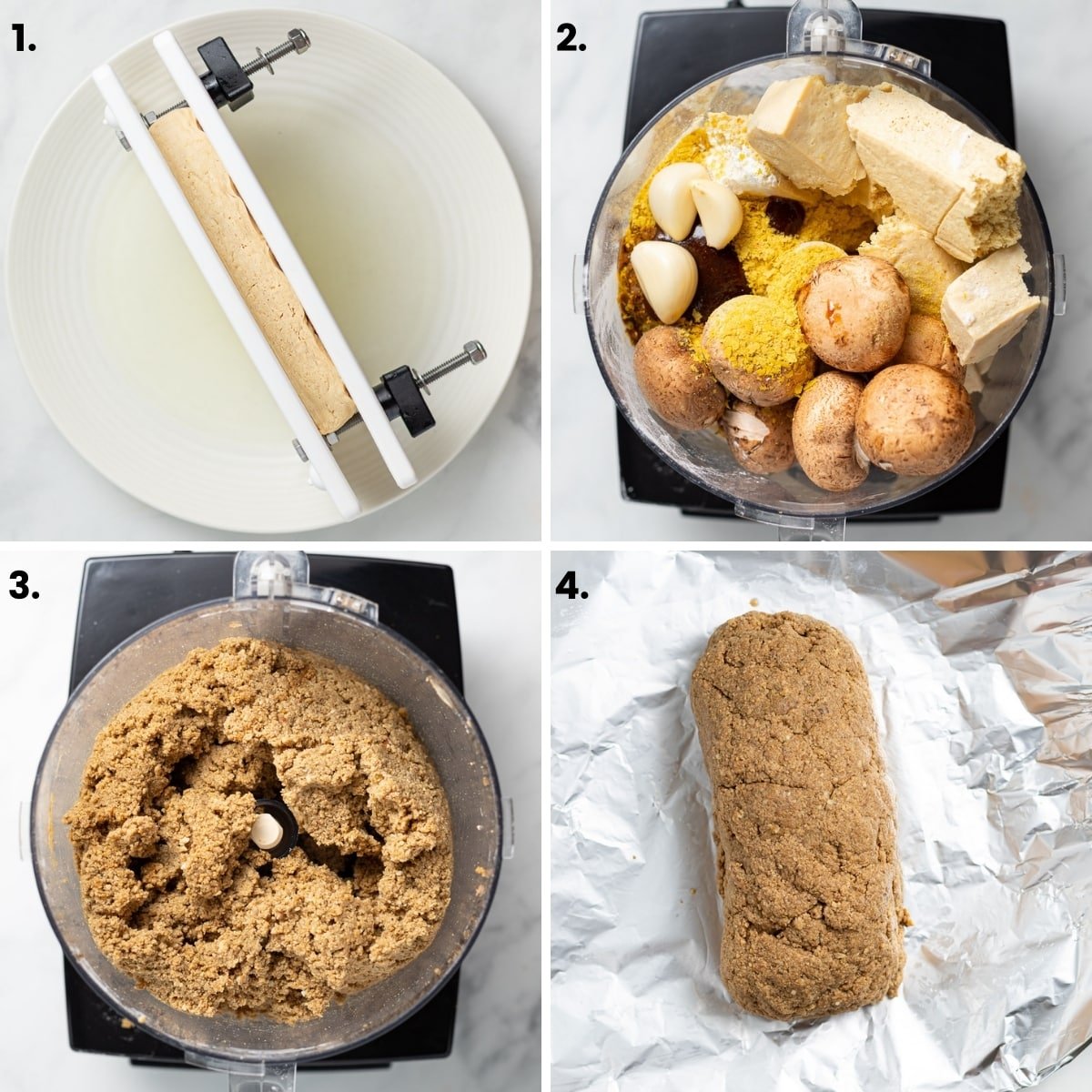
Step 5 - Place on a small baking tray and bake turning over half way through.
Step 7 - Leave it to rest, unopened, for at least 1 hour. It will be really swollen but will deflate as it cools. If you want an even better texture, refrigerate it and use it the next day.
Success tips
- Follow every step in this recipe exactly for the best results.
- Don't have a tofu press? Wrap the block of tofu in a clean dish towel, and place something heavy like a stack of heavy cookbooks, or a skillet with tin cans inside it on top of it.
- The nutritional yeast, mushrooms, and other seasonings are really important for flavour. Don't omit or change them.
- You'll know the dough is ready when you can squeeze some together in your hand and it holds. If it doesn't, gradually add a little more water and pulse in between each addition.
- Do not try steaming or boiling this like you would with regular seitan. It won't work.
- You must cook the seitan in foil. If you want to protect your food from touching the foil, wrap it in some parchment paper first before wrapping in the foil.
- Don't wrap the seitan too tightly in the foil because it expands a lot while cooking and will burst out.
- When it comes out of the oven, the seitan will have expanded a lot. If you poke the foil it will feel tight and hard but don't worry, it will shrink and soften as it cools.
- The seitan only gets better the longer it sits in the fridge. I like to make it a minimum of 1 day ahead of time.
What to serve with gluten-free seitan
My gluten-free seitan roast tastes great hot, cold, or at room temperature. Slice it up and serve it with your holiday meal or Sunday roast!
It would make a great main dish with gravy, mashed sweet potato, vegan cranberry sauce, gluten-free Yorkshire puddings, crispy roasted potatoes, and Brussels sprout salad on the side.
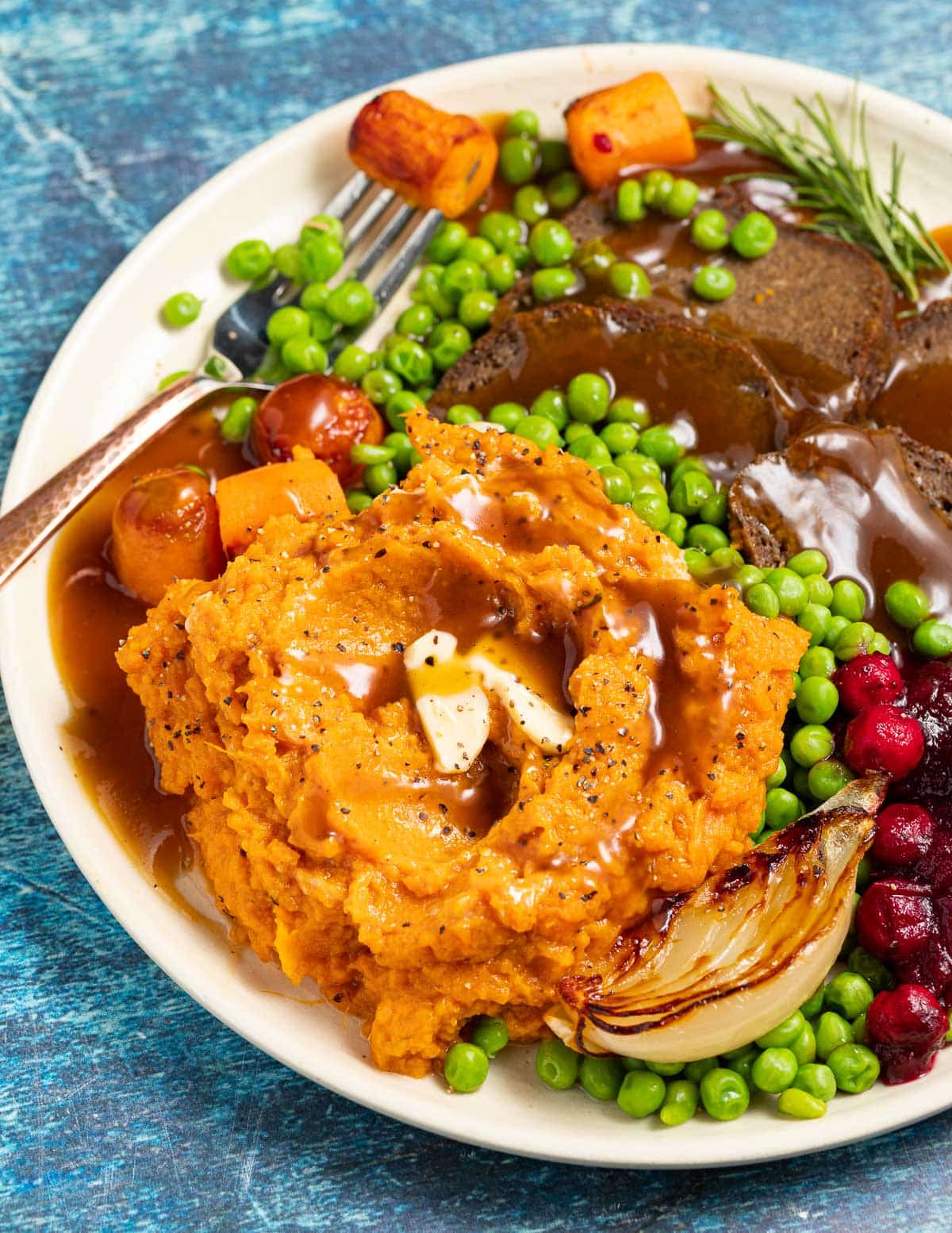
If you don't need an extravagant meal, or you have leftovers, slice it up thinly and add it to a sandwich with freshly made gluten-free bread, chutney and salad leaves or cube and toss through a fresh salad.
How to store and reheat
This roast will keep for up to a week in the fridge. Just keep it wrapped tightly in foil or in an airtight container.
To reheat, either place the whole roll or a few slices wrapped in foil in a 350ºF oven for 10-15 minutes (depending on the amount). Or allow it to come to room temperature and cover with hot gravy. It's just as good when eaten at room temperature as well!
Hungry for more?
Try these gluten-friendly recipes:
Recipe

Gluten-Free Seitan Roast
Author:Ingredients
*IMPORTANT - Before you make this recipe you MUST have previously frozen the tofu in its packets for at least 2 full days. It then needs to be defrosted before you proceed. This step cannot be skipped.
- 700 g / 25 oz extra firm tofu (about 2 packs depending on the brand) , that has been frozen in the packets it came in (without opening) for at least 2 days and then defrosted.
- ½ cup / 60 grams tapioca flour/starch
- 6 tablespoons / 54 grams psyllium husk powder
- 4 tablespoons / 28 grams nutritional yeast
- 4 teaspoons dried thyme
- 2 teaspoons rubbed sage , or 1 teaspoon ground sage
- 2 teaspoons onion powder
- 5 cloves garlic
- 8 shitake or cremini/ baby bella mushrooms , (chestnut mushrooms in the UK).
- 4 teaspoons Better Than Bouillon No Chicken Base , or No Beef Base. Or use 2 GF stock cubes.
- 2 tablespoons gluten-free Tamari / gluten-free soy sauce , or coconut aminos
- ½ teaspoon freshly ground black pepper
- water as needed to bring it together
RECOMMENDED EQUIPMENT
INSTRUCTIONS
- *IMPORTANT - Before you make this recipe you MUST have previously frozen the tofu in its packets for at least 2 full days. It then needs to be defrosted before you proceed. This step cannot be skipped.
- Press the previously frozen and defrosted tofu for at least 15 minutes. Use a tofu press if you have one and if you don't, wrap the blocks of tofu in a clean dish towel, and place something heavy like a stack of heavy cookbooks, or a skillet with tin cans inside it on top of it.
- Preheat oven to 400 °F (200 °C).
- Break the pressed tofu up into chunks and put it in a food processor. Add everything else except the water and blend it up until it looks crumby.
- Check to see if it will squeeze together and stay together in your hand. It probably won't. If not, gradually add water, a few teaspoons at a time and pulse in between each addition. Lift the lid after adding each addition and carefully (avoiding the blade) squeeze a bit of the mixture together in your hand to see if it sticks together. If it's not quite there add another teaspoon or two, pulse a few times and check again. It will probably take about 3 to 4 tablespoons.
- Remove the blade, scraping it off with a spatula, then use the spatula to give the bottom of the food processor a bit of a scrape, particularly around the blade area, to get any bits of dried tapioca or psyllium husk that got missed, mixed in and absorbed.
- Get a long piece of foil (around 20 inches long) and brush or rub the dull side with a little oil.
- Tip the seitan dough out on a board and roughly shape it into a log with a diameter of about 4 inches. It doesn't need to be perfect. Move it onto the foil (long side of roast along the short side of foil, and roll it up loosely. Not too tightly as it will increase in size as it cooks and will burst out of the foil if too tight. Twist each end shut.
- Place the foil-wrapped seitan onto a small baking tray and place on the middle shelf of the oven and bake for 35 minutes. Open the oven, turn the seitan over and bake for another 35 minutes. Remove from the oven. It will have expanded and if you poke the foil it will feel tight and hard but it will shrink and soften as it cools. Leave it unopened to rest on the tray for at least an hour, but the texture is better if you let it cool completely and refrigerate it. I tend to make it at least the day before I want to use it.
NOTES
- Follow every step in this recipe exactly for the best results.
- Don't have a tofu press? Wrap the block of tofu in a clean dish towel, and place something heavy like a stack of heavy cookbooks, or a skillet with tin cans inside it on top of it.
- The nutritional yeast, mushrooms, and other seasonings are really important for flavour. Don't omit or change them.
- You'll know the dough is ready when you can squeeze some together in your hand and it holds. If it doesn't, gradually add a little more water and pulse in between each addition.
- Do not try steaming or boiling this like you would with regular seitan. It won't work.
- You must cook the seitan in foil. If you want to protect your food from touching the foil, wrap it in some parchment paper first before wrapping in the foil.
- Don't wrap the seitan too tightly in the foil because it expands a lot while cooking and will burst out.
- When it comes out of the oven, the seitan will have expanded a lot. If you poke the foil it will feel tight and hard but don't worry, it will shrink and soften as it cools.
- The seitan only gets better the longer it sits in the fridge. I like to make it a minimum of 1 day ahead of time.
💌 SAVE THIS RECIPE!
Watch out for more tasty treats coming your way too! Unsubscribe at any time.
NUTRITION
Recipe FAQs
This step is non-negotiable and cannot be skipped. Freezing the tofu changes the texture, making it much drier, firmer and chewier. And it must be frozen for at least 2 days. If you don't freeze the tofu first the texture of this roast isn't anywhere near as good. Don't think you can skip the freezing and just press it longer. That will not replicate the same texture. it absolutely has to be frozen.
No. For this recipe you must use extra firm tofu.
I do not recommend you use anything else in place of it.
There is nothing else that you can use instead. It is essential in this recipe.
The mushrooms are really important for meaty flavour. You could use half a cup of marinated artichokes instead but be sure to blot them thoroughly so they aren't wet when they go in. Your roast will not taste as good without the mushrooms though.



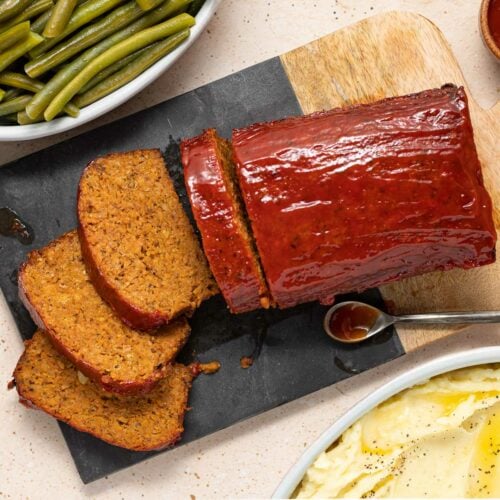
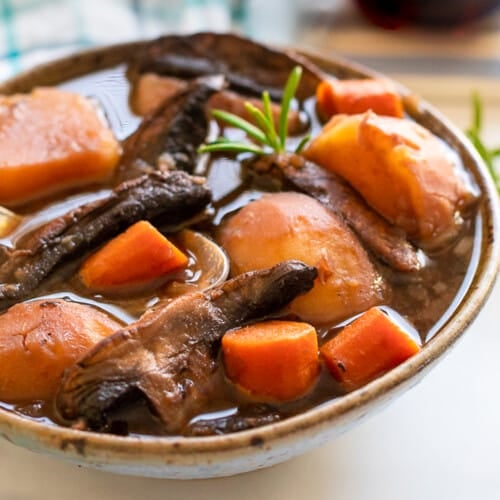
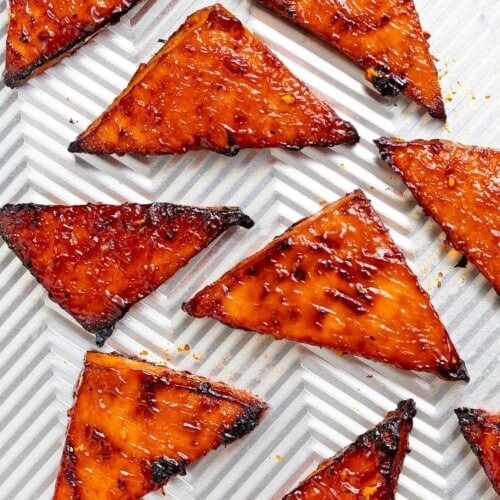
Pearline Storer says
Can the Gluten free Seitan be frozen once it is cooked please?
Melanie McDonald says
I've never tried it but I think it will be fine. It might even improve the meaty texture.
Tammy says
The flavor is amazing. The texture I got was solid but kind of a gummy texture. Did I do something wrong?
Lynne says
Better than Bouillon is not gluten free.
Melanie McDonald says
The ingredients of Better than Bouillon No Beef and No Chicken are gluten-free. However the product is made in a facility that processes wheat for other products. That's good enough for a lot of GF people, but for celiacs or anyone with a severe gluten intolerance it does clearly say in the recipe "or use GF stock cubes".